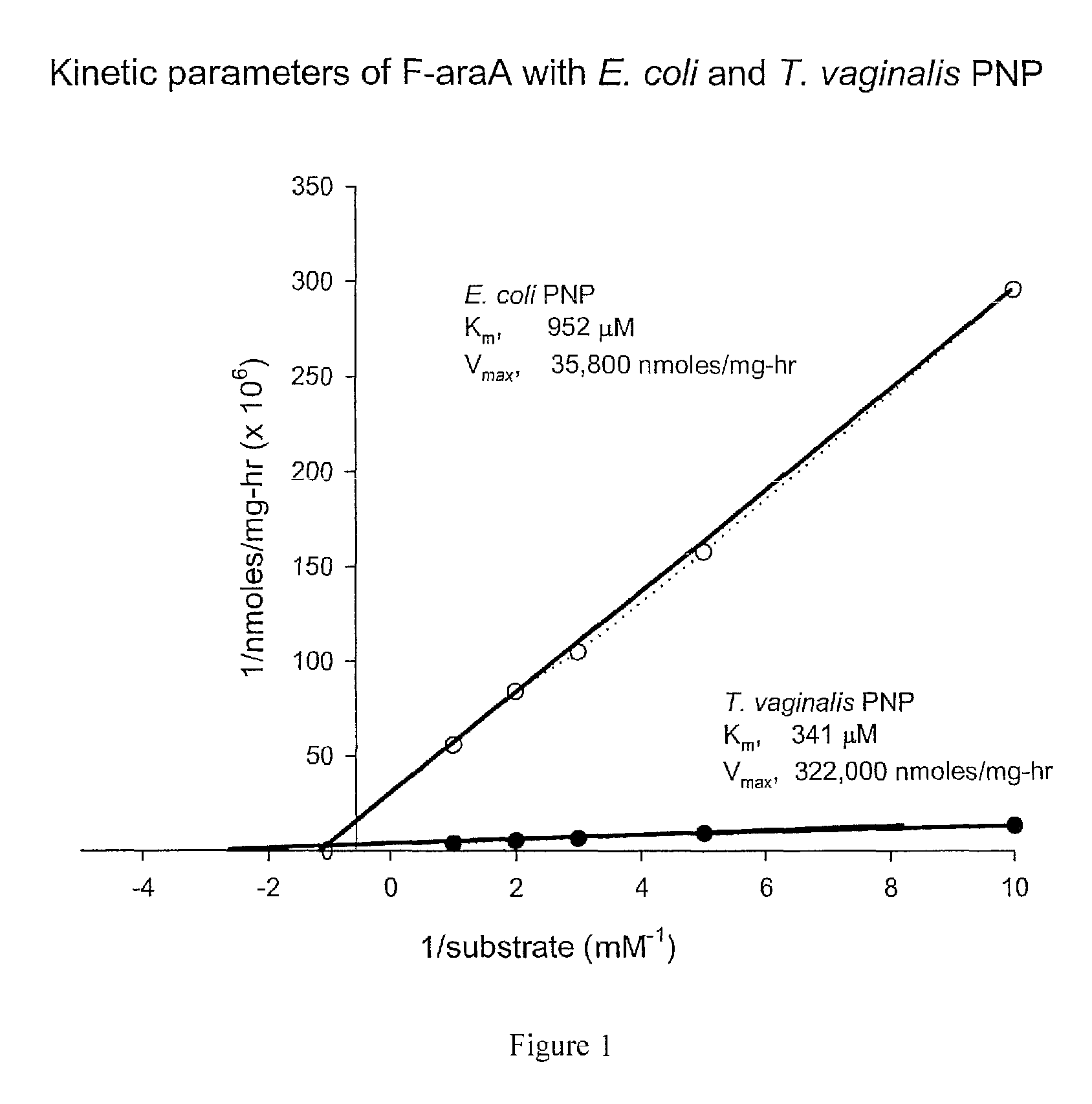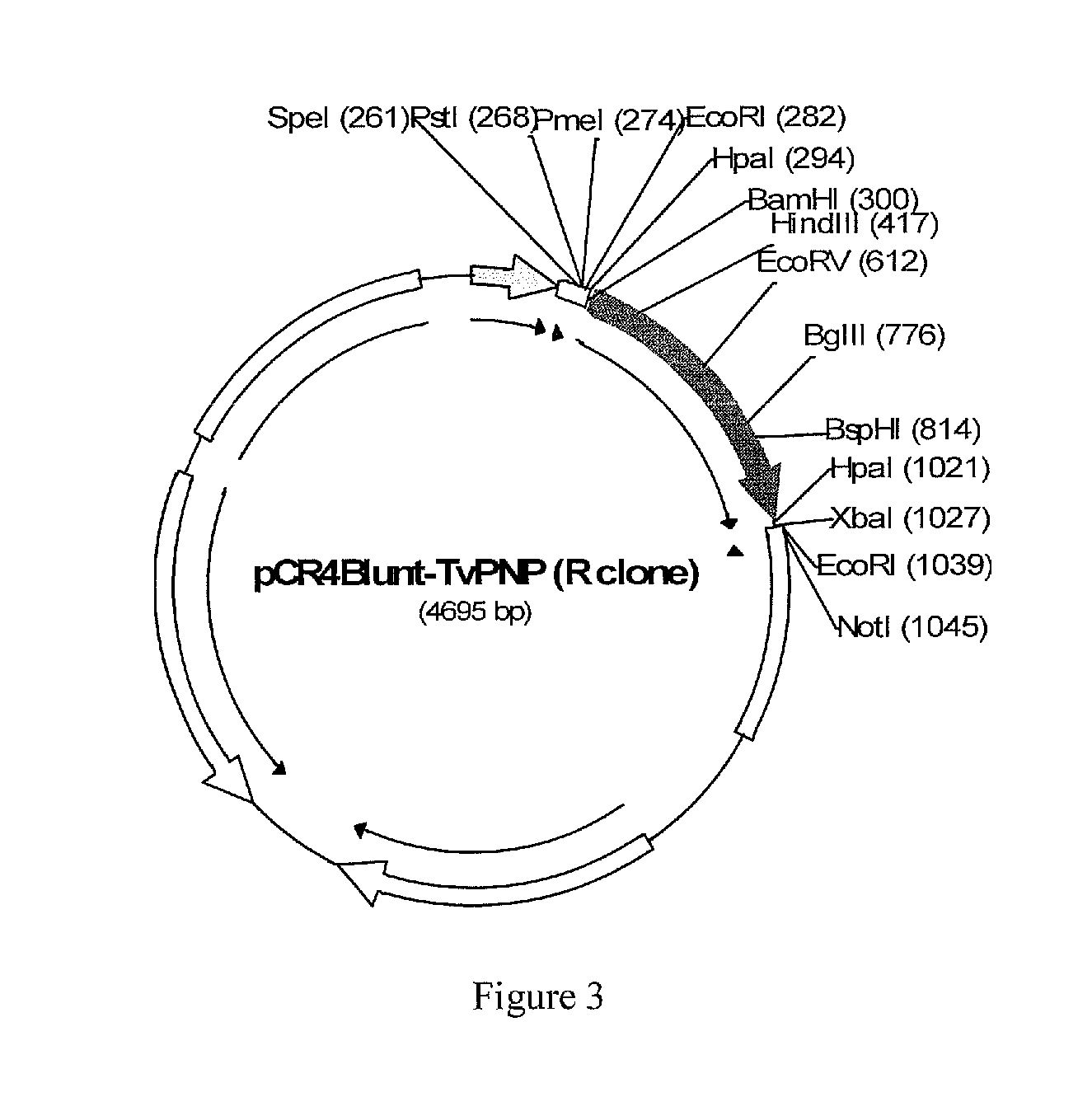Purine nucleoside phosphorylase as enzymatic activator of nucleoside prodrugs
a technology of nucleoside prodrugs and purine nucleoside phosphorylase, which is applied in the direction of transferases, peptide/protein ingredients, drug compositions, etc., can solve the problems of unwanted immunosuppressive effects, limited tumor treatment using prodrug activation techniques, and inability to search for purine nucleoside phosphorylases with cleavage activity for the important chemotherapeutic f-araa
- Summary
- Abstract
- Description
- Claims
- Application Information
AI Technical Summary
Benefits of technology
Problems solved by technology
Method used
Image
Examples
example 1
Synthesis of Tv-PNP Expression Vectors
[0122]T. vaginalis genomic DNA is obtained with a first DNA clone from metronidazole-resistant strain (R: CDC955) and a second DNA clone from sensitive strain (S3: CDC520). TvPNP gene is amplified by PCR using following primers from both samples using AccuPrime Pfx supermix (Invitrogen). The primers are designed based on the TvPNP sequence downloaded from TIGR trichomonas genome project web site. The sequence is currently available at GenBank (XM—001323400). Tv-PNP primers used herein included with parenthetical restriction sites therein: forward primer TvPNP-F: 5′-GTTAACGGATCCATGGCAACACCCCATAACTCTGCT-3′ (HpaI & BamHI) (SEQ ID NO: 1). Tv-PNP reverse primers TvPNP-R: 5′-TCTAGAGTTAACGTCCTTATAATTTGATTGCTGCTTC-3′ (XbaI & HpaI) (SEQ ID NO: 2) and TvPNP-R1: 5′-ATAGTTTAGATCCGAGGACCAATCAT-3′ (SEQ ID NO. 3). The nucleotide sequence of wild-type Tv-PNP is illustrated as SEQ ID NO: 4. The amino acid sequence of wild-type Tv-PNP is SEQ ID NO: 5.
[0123]The fi...
example 2
Identifying Candidate Prodrugs for Tv-PNP Enzymes
[0126]The following method is useful to identify substrates that are cleaved more efficiently by the wild-type Tv-PNP than by wild-type E. coli PNP or other PNPs. Prodrugs identified by this method can then be further assessed in animal studies for determination of toxicity, suitability for administration with various pharmaceutical carriers, and other pharmacological properties.
[0127]The method quantitatively measures the cleavage of substrates in vitro. The purine analog nucleosides (0.1 mM in 500 μl of 100 mM HEPES, pH 7.4, 50 mM potassium phosphate) are combined with 100 μg / ml Tv-PNP or wild-type E. coli PNP. The reaction mixtures are incubated at 25° C. for 1 hour, and the reactions stopped by boiling each sample for 2 minutes. Protein concentration and time of assay are varied depending on activity of enzyme for a particular substrate. Each sample is analyzed by reverse phase HPLC to measure conversion from substrate to product....
example 3
Comparison of the Ability of Various PNPs to Cleave MeP-dR and F-araA
[0133]The relative cleavage activity of PNPs of various origins is compared to determine the optimal enzyme for cleavage of the important chemotherapeutics MeP-dR and F-araA by the procedure of Example 2. Enzymes of various purities are incubated with 100 μM MeP-dR or F-araA and the rate of cleavage is determined by measuring the production of product (MeP or F-Ade) by HPLC as described in Example 2. The results are provided in Table 2.
[0134]
TABLE 2F-araAMeP-dR / OrganismMeP-dRnmoles / mg / hrF-araAhuman PNP35>35T. vaginalis PNP536,00030,00018E. coli PNP528,0001,250422A. areogenes PNP6,63810464A. Laidlawii PNP6,09019320Klebsiella sp PNP11,43232357Salmonella typhimurium PNP9,15020458B. cereus PNP1,400,00013,000108Tularemia PNP4,90018272T. Bruceii hydrolase750>750E. Coli PNP mutant M65V18233.9469tm-PNP9484.8198
PUM
| Property | Measurement | Unit |
|---|---|---|
| total volume | aaaaa | aaaaa |
| total volume | aaaaa | aaaaa |
| volumes | aaaaa | aaaaa |
Abstract
Description
Claims
Application Information
 Login to View More
Login to View More - R&D
- Intellectual Property
- Life Sciences
- Materials
- Tech Scout
- Unparalleled Data Quality
- Higher Quality Content
- 60% Fewer Hallucinations
Browse by: Latest US Patents, China's latest patents, Technical Efficacy Thesaurus, Application Domain, Technology Topic, Popular Technical Reports.
© 2025 PatSnap. All rights reserved.Legal|Privacy policy|Modern Slavery Act Transparency Statement|Sitemap|About US| Contact US: help@patsnap.com



